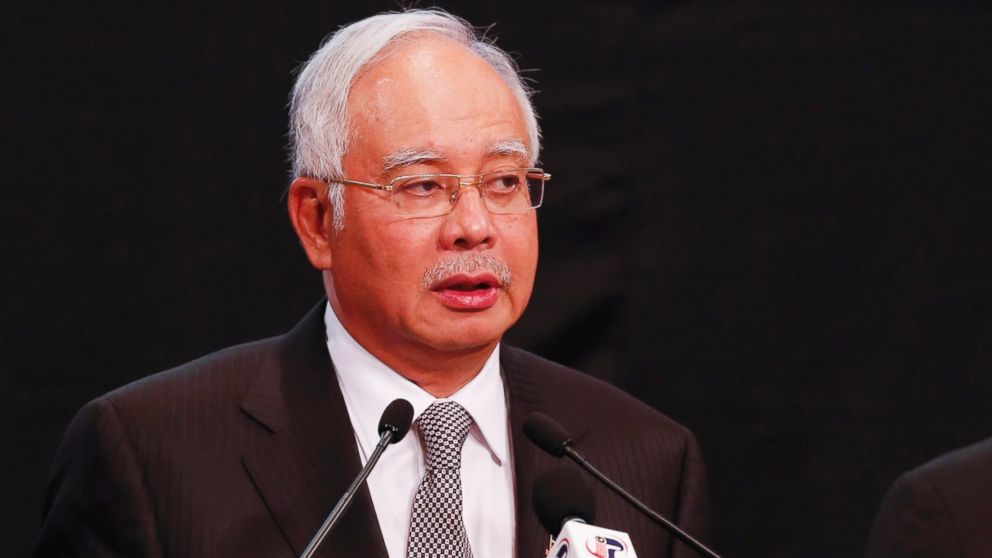
PERTH, Australia – Malaysia’s prime minister said Thursday the search for the missing jetliner will not stop until answers are found, as his Australian counterpart Tony Abbott called it “the most difficult in human history.”
Prime Minister Najib Razak met with Abbott at the Australian base near Perth that is serving as the hub for the multinational effort and was briefed by Angus Houston, the head of a joint agency co-ordinating the search in the southern Indian Ocean.
No trace of the Boeing 777 has been found nearly a month after it vanished in the early hours of March 8 on a flight from Kuala Lumpur to Beijing with 239 people on board.
“It is a very difficult search. The most difficult in human history, but as far as Australia is concerned, we are throwing everything we have at it,” Abbott told reporters.
Najib’s trip to Perth reinforces the reality that while Australia is co-ordinating the ocean search, the investigation into the tragedy ultimately remains Malaysia’s responsibility. On Thursday, Najib said Australia had agreed to act as an “accredited representative in the investigation,” and would be working with Malaysia to draw up a comprehensive agreement on the search.
Despite a lack of answers into the mystery of Flight 370, Najib sounded a hopeful note during his visit.
“We want to provide comfort to the families and we will not rest until answers are indeed found,” he said. “In due time, we will provide a closure for this event.”
On Wednesday, officials warned that the investigation may never produce answers into why the Malaysia Airlines jet disappeared. A frustrating dearth of information has plagued investigators from the moment the plane’s transponders, which make the plane visible to commercial radar, were shut off.
Military radar picked up the jet just under an hour later, on the other side of the Malay Peninsula. Authorities say that until then, its “movements were consistent with deliberate action by someone on the plane,” but have not ruled out anything, including mechanical error.
Police are investigating the pilots and crew for any evidence suggesting they may have hijacked or sabotaged the plane. The backgrounds of the passengers, two-thirds of them Chinese, have been checked by local and international investigators and nothing suspicious has been found.
The search for the plane began over the Gulf of Thailand and South China Sea, where the plane’s last communications were, and then shifted west to the Strait of Malacca. Experts then analyzed hourly satellite “handshakes” between the plane and a satellite and now believe it crashed somewhere in the southern Indian Ocean.
Search planes initially began looking in a remote area southwest of Perth before moving the search zone 1,100 kilometres (680 miles) to the north after a new analysis of the data showed the plane was travelling faster, and therefore likely ran out of fuel earlier than they first thought.
Despite more than two weeks of scouring the remote waters, no trace of the plane’s wreckage has been found. Houston has said there is no timeframe for ending the search, but acknowledged a new approach will eventually be needed if nothing turns up.
As each day passes with no wreckage sighted, the chances of finding the plane grow slimmer. Even Australia’s prime minister, who has repeatedly said that he is certain that if any wreckage is out there, it will be found, took a more cautious stance when speaking Thursday at the base.
“I am confident that everything that possibly can be done to find this aircraft will be done,” Abbott said. “We cannot be certain of success, but we can be certain of the professionalism and the effort that will be brought to the task.”
Najib said during a press conference in Perth on Thursday that despite the challenges, “a new refined area of search has given us hope.” It was not immediately clear if he was speaking specifically of Thursday’s search zone – a 223,000 square kilometre (86,000 square mile) patch of ocean, 1,680 kilometres (1,040 miles) northwest of Perth – or referring to the general area crews have been scouring since moving the search zone farther north last week. He took no questions during the press conference.
“I know that until we find the plane, many families cannot start to grieve. I cannot imagine what they must be going through,” Najib said. “But I can promise them that we will not give up.”
The Joint Agency Coordination Center, which oversees the search efforts, said up to eight planes and nine ships were involved in Thursday’s search. Weather was fair, though the southern section of the search zone could experience some showers.
Two British vessels, a nuclear-powered submarine with advanced underwater search capability, and the British Survey ship HMS Echo, have also joined the hunt, Houston said. The Ocean Shield, an Australian warship carrying a U.S. device that detects “pings” from the plane’s flight recorders, was en route.
With no other data available indicating where the plane went down, spotting wreckage is key to narrowing down the search area and ultimately finding the plane’s data recorders, which would provide a wealth of information about the condition the plane was flying under and the communications or sounds in the cockpit.
The data recorders emit a “ping” that can be detected by special equipment towed by a ship in the immediate vicinity. But the battery-powered recorders stop transmitting the pings about 30 days after a crash. Locating the data recorders and wreckage after that is possible, but it becomes an even more daunting task.
___
Ng reported from Kuala Lumpur, Malaysia. Associated Press writers Rod McGuirk in Canberra, Australia, and Kristen Gelineau in Sydney contributed to this report.